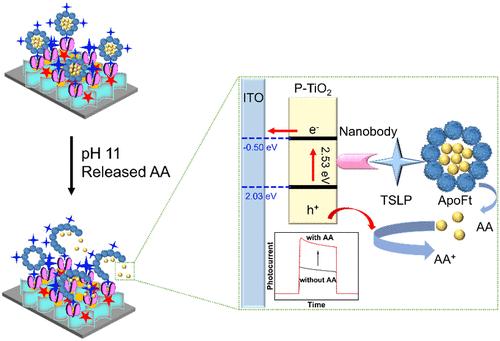载铁蛋白包封抗坏血酸作为原卟啉敏化TiO2纳米阵列的光电纳米体微流控生物传感器
IF 6.7
1区 化学
Q1 CHEMISTRY, ANALYTICAL
引用次数: 0
摘要
在这项工作中,利用原卟啉敏化TiO2纳米阵列作为信号传感器,开发了一种基于纳米体的微流控光电电化学传感器,用于检测胸腺基质淋巴生成素(TSLP),这是哮喘的典型生物标志物。采用磁控溅射和原位氧化的方法在ITO衬底上制备了TiO2纳米阵列,并通过原卟啉染料敏化提高了其可见光吸收和光生载流子性能。将电子供体抗坏血酸(AA)包裹在载铁蛋白(ApoFt)内,直接偶联到目标TSLP上,得到ApoFt@AA-TSLP生物偶联物,随后将其与不同浓度的TSLP混合并添加到电极表面,使AA的定量释放依赖于铁蛋白外壳的拆卸/重组特性。检测过程被集成到一个小型化的微流控传感器芯片中,以防止传感界面的生物分子泄漏。值得注意的是,在该系统中使用纳米体代替传统的单克隆抗体来抵消AA释放过程中强碱性刺激表位引起的活性丧失。该传感器具有高特异性、稳定性和重复性,对TSLP在1.00 ~ 1.00 μg/mL的线性范围内具有敏感的光电化学响应,检测限低至0.08 ng/mL,显示其在检测蛋白质相关疾病的生物标志物方面具有重要的潜力。本文章由计算机程序翻译,如有差异,请以英文原文为准。

Ascorbic Acid Encapsulated in Apoferritin as Improved Protoporphyrin-Sensitized TiO2 Nanoarrays of a Photoelectrochemical Nanobody-Based Microfluidic Biosensor for Immunoassay
In this work, a nanobody-based microfluidic photoelectrochemical sensor utilizing protoporphyrin-sensitized TiO2 nanoarrays as signal transducer was developed for the detection of thymic stromal lymphopoietin (TSLP), a typical biomarker of asthma. The TiO2 nanoarrays were fabricated on ITO substrates via magnetron sputtering and in situ oxidation, and their visible light absorption and photogenerated carrier properties were improved upon sensitization with protoporphyrin dye. The electron donor ascorbic acid (AA) was encapsulated within apoferritin (ApoFt) and coupled directly to the target TSLP to obtain the ApoFt@AA-TSLP bioconjugate, which was subsequently mixed with different concentrations of TSLP and added to the electrode surface, enabling the quantitative release of AA dependent on the disassembly/reassembly properties of the ferritin shell. The detection process was integrated into a miniaturized microfluidic sensor chip to prevent biomolecular leakage at the sensing interface. Notably, nanobodies were employed in this system instead of traditional monoclonal antibodies to counteract the loss of activity induced by strong alkaline stimulation of the epitope during AA release. The sensor is high specificity, stability, and reproducibility with a sensitive photoelectrochemical response to TSLP in a linear range of 1.00 ng/mL to 1.00 μg/mL and a limit of detection as low as 0.08 ng/mL, demonstrating its significant potential for detecting biomarkers of protein-related diseases.
求助全文
通过发布文献求助,成功后即可免费获取论文全文。
去求助
来源期刊

Analytical Chemistry
化学-分析化学
CiteScore
12.10
自引率
12.20%
发文量
1949
审稿时长
1.4 months
期刊介绍:
Analytical Chemistry, a peer-reviewed research journal, focuses on disseminating new and original knowledge across all branches of analytical chemistry. Fundamental articles may explore general principles of chemical measurement science and need not directly address existing or potential analytical methodology. They can be entirely theoretical or report experimental results. Contributions may cover various phases of analytical operations, including sampling, bioanalysis, electrochemistry, mass spectrometry, microscale and nanoscale systems, environmental analysis, separations, spectroscopy, chemical reactions and selectivity, instrumentation, imaging, surface analysis, and data processing. Papers discussing known analytical methods should present a significant, original application of the method, a notable improvement, or results on an important analyte.
 求助内容:
求助内容: 应助结果提醒方式:
应助结果提醒方式:


